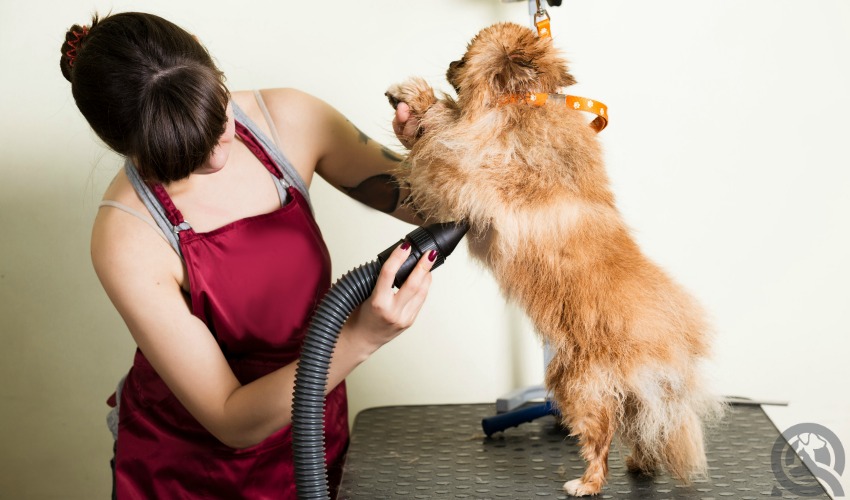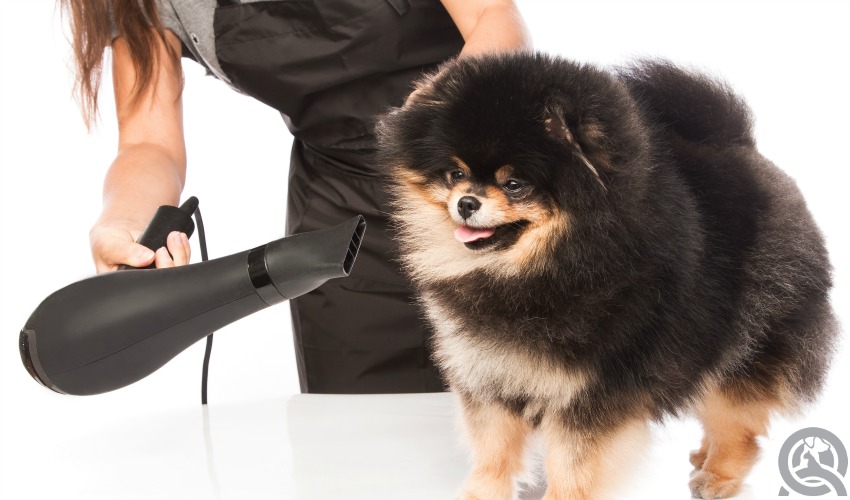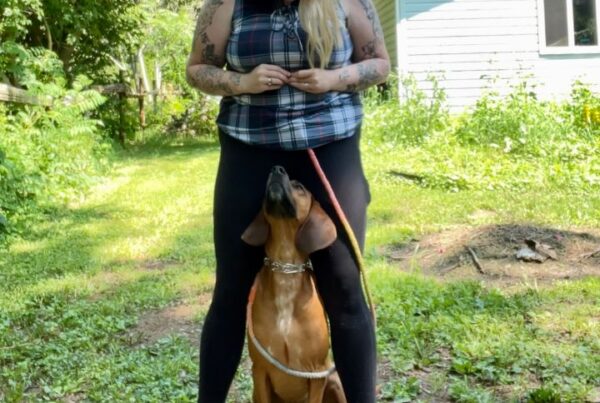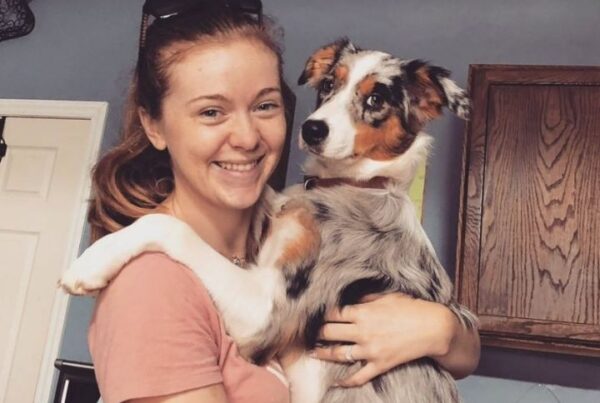As a groomer, the health and cleanliness of the dogs you care for is extremely important. Bathing, brushing, and drying are a few of the tasks required to keep dogs hygienic and happy! Making the right equipment choices is key. When it comes to hair dryers, dog groomers do not use human hair dryers, but rather specialized dryers (and usually several different ones) that perform different tasks for each dog.
So how does a dog groomer choose the best hair dryer for their furry clients? There are several factors to consider, such as budget, temperature, speed, type of dog, and storage within your salon. As a new dog groomer, we recommend purchasing a high-velocity dryer, while more experienced groomers can purchase a stand dryer as a second option. Read on for our full guide to different dog dryers, and get some great product suggestions!
How Dog Dryers Work
Before doing your research into equipment, it’s important to be informed about how dog dryers work. Bathing is one of the most popular services offered by a dog groomer, and clients expect that their pet will look his absolute best once he leaves the salon. In order to ensure that dogs leave your salon with a straight coat (which is very important, as achieving any kind of style will be difficult without it) hair drying is an essential part of the process, especially in the winter months!
Once the dog is bathed, get rid of excess water by gently soaking it up with a towel. Then, use a dryer specifically tailored to that dog’s hair (more on this below) and turn it to a warm setting on the highest airflow speed. Brush carefully while you dry, and be sure to completely dry the coat.

Different Dryer Types
As a dog groomer, you will undoubtedly care for different types of dogs. This means different types of hair. Once you’ve bathed and de-matted a dog, you’ll need to dry his coat.
Here’s an outline of the functions of 5 common dog dryers as well as some important points to be mindful of!
1. Forced-air dryer:
High-velocity dryers, also known as “forced-air dryers”, use high-pressure air to blow excess water out of a dog’s coat and are the most powerful and efficient dryers on the market. In terms of appearance, these dryers resemble a canister vacuum cleaner, but blow air out rather than sucking it in. Some major benefits of the high-velocity dryer are that it straightens and dries the coat while simultaneously pushing it straight. As a result, groomers do not have to constantly brush while drying.
Cubic feet per minute (CFM) is a measurement of how many cubic feet of air a dryer can blast out per minute, so when shopping for a high-velocity dryer, look for one with a flow between 100 and 300 CFM (170 to 500 cubic metres per hour), as well as one that has padding or a special casing to minimize noise. This will help your dogs feel more comfortable during the dry! It is also extremely important to protect yourself while using a high-velocity dryer, and we recommend wearing protective head gear.
Product Recommendation: Metrovac Air Force Commander Professional Dog Dryer
2. Stand dryer:
Also known as a “fluff dryer”, stand dryers are attached to an accompanying stand. They allow you the freedom to brush and maneuver the dog while drying. Some dogs have hair that needs to be brushed as it’s dried in order to prevent tangles and achieve the correct style, and the stand dryer is the only type of unit that allows groomers to comb, brush, and style the dog as they dry.
Due to the fact that stand dryers are much quieter than high and low pressure dryers, dogs that are afraid of high-velocity dryers may be more comfortable with a stand dryer.
Product Recommendation: Oster Hi-Velocity Adjustable Table and Cage Dryer
3. Low-pressure dryer:
High quantities of air are blown out of these dryers at a much lower pressure than forced-air dryers, allowing groomers to dry sensitive coat types and delicate areas. However, these dryers do not dry fur as quickly as high-velocity dryers, and some units heat up which can put the dog at risk of burns, irritation, and heat stroke. If a dog has sensitive skin or thin fur, low-pressure dryers should be avoided.

4. Handheld dryer:
This dryer may look very similar to a human hair dryer, but is completely different in terms of its functionality, as it is specially designed for dogs. A human dryer should never be used to dry a dog, as it can be too hot and also will not have the power required to properly dry a dog’s coat.
Handheld dryers are an inexpensive choice, and are a great way to introduce puppies to the drying process – just keep in mind that the lowest heat setting is safest.
Product Recommendation: Comfort Dry Dryer by Andis
5. Cage dryer:
Similar to the low-pressure dryer mentioned above, cage dryers are designed for use on a dog secured within a cage. This is a convenient option as it allows the groomer to begin drying a second dog while the first dog is drying, and are great options for dogs with sensitive skin or thin fur, as low pressure air likely will not hurt them.
As cage dryers use heat, the dogs can be at risk of heatstroke, especially if left alone in the cage. Alternatively, a wet dog can begin to shiver in a cage dryer without the use of heat, and this chill can put older or sick dogs at risk of hypothermia.
Cage dryers are a great choice for an experienced groomer who can ensure the animal is safe and comfortable.
Product Recommendation: Grizzly B-Air Cub Single Cage Dryers
Purchasing grooming equipment as you begin your career requires research, as well as an understanding of how different items work. Use the suggestions above as a guide when purchasing the best dog dryer for your grooming business!
Now that you have an understanding of how to keep a dog safe and happy during the drying process, be sure to avoid these rookie grooming mistakes!








The low pressure dryer is the best one. Even though it takes time but my dog don’t irritate me while I’m grooming him.
Thanks so much for reading and for leaving such a great comment. 🙂 We definitely agree that low-pressure dryers are the best option for many dogs, and we’re glad that you’ve found that it works best for you! <3
All the best,
The QC Team
Keep up the great work! Thank you so much for sharing a great posts.
Hi Declan,
Thanks so much for taking the time to read our article, and for leaving such a kind comment. 🙂 We’re very glad that you found the information in this post to be useful. Out of curiosity, what tip in this post did you find the MOST helpful? We’d love to know! <3
All the best,
The QC Team
Great blog post.Helpful and informative tips. I like it thanks for sharing this information with us
Hi there, thank you so much for taking the time to read our article, and for leaving such a great comment. 🙂 Out of curiosity, which tip discussed in this blog post did YOU find the most helpful? We’d love to know!
All the best,
The QC Team